behavior reflection sheet middle school pdf
A Behavior Reflection Sheet is a tool for middle school students to self-reflect on actions and consequences․ It encourages accountability, helping them understand their impact and is customizable for individual needs․
1․1 What is a Behavior Reflection Sheet?
A Behavior Reflection Sheet is a structured tool designed to help students reflect on their actions and their impact on others․ It provides a guided format for self-assessment, encouraging accountability and thoughtful consideration of behavior․ Typically used in middle school settings, it prompts students to describe what happened, why their actions were inappropriate, and how they can improve․ This document fosters personal growth by helping students identify patterns, take responsibility, and develop better decision-making skills․ Teachers and parents use it to promote self-awareness and positive change․
1․2 Why Use a Behavior Reflection Sheet in Middle School?
Behavior Reflection Sheets are particularly effective in middle school as they help students navigate social and emotional challenges․ They provide a structured way for students to process their actions, understand consequences, and develop accountability․ By encouraging self-reflection, these sheets promote personal growth and better decision-making․ They also help teachers and parents address behavioral issues constructively, fostering a supportive learning environment․ Middle school is a critical time for social development, making reflection sheets a valuable tool for teaching responsibility and empathy․
Importance and Benefits of Behavior Reflection Sheets
Behavior Reflection Sheets promote accountability, self-awareness, and positive change, helping students understand consequences and develop better decision-making skills․ They also foster social-emotional learning and a supportive classroom environment․
2․1 Promoting Self-Reflection and Accountability
Behavior Reflection Sheets encourage students to think critically about their actions, fostering self-reflection and accountability․ By identifying mistakes and understanding their impact, students take ownership of their behavior and develop a sense of responsibility․ These tools guide students to examine consequences, promoting better decision-making and personal growth․ Regular use of reflection sheets helps students recognize patterns in their behavior and develop strategies for improvement, leading to enhanced self-awareness and accountability in their academic and social interactions․
2․2 Encouraging Positive Behavioral Change
Behavior Reflection Sheets are instrumental in fostering positive behavioral change by guiding students to analyze their actions and their consequences․ These tools help students identify triggers, consider alternative responses, and develop empathy for those affected․ By reflecting on their choices, students can set goals for improvement, fostering a mindset of personal growth․ Consistent use of reflection sheets encourages students to adopt more constructive behaviors, leading to a more positive and respectful classroom environment․ This process empowers students to take charge of their actions and strive for better outcomes․

Designing a Behavior Reflection Sheet
Designing a Behavior Reflection Sheet involves creating structured prompts to guide students in analyzing their actions, understanding reasons, and setting goals for improvement․ Customize for middle school needs․
3․1 Structure and Components of an Effective Reflection Sheet
An effective reflection sheet includes sections for describing the incident, identifying inappropriate behavior, and exploring its impact․ Students should outline actions taken, reasons behind them, and how to improve․ Key components are open-ended questions, self-assessment prompts, and goal-setting areas․ Clear language and focused structure help guide middle schoolers in thoughtful reflection, fostering accountability and growth․ Customize sections to address specific behaviors or classroom needs, ensuring relevance and engagement for students․
3․2 Customizing the Sheet for Middle School Students
Customizing reflection sheets for middle school students involves tailoring questions to their developmental level․ Use clear, concise language and relatable scenarios to engage young minds․ Incorporate visual aids or prompts to simplify complex emotions․ Allow space for creative expression, such as drawing or writing, to cater to different learning styles․ Additionally, align the sheet with classroom rules and social-emotional learning goals to reinforce positive behaviors and provide a structured yet flexible tool for personal growth and accountability․
3․3 Examples of Effective Questions to Include
Effective reflection sheets include questions that prompt deep thinking, such as: “What did I do?” and “Why was this behavior inappropriate?” Ask students to identify the impact of their actions on others and themselves․ Include questions like, “How can I make better choices in the future?” or “What steps will I take to improve?” These questions encourage accountability, self-awareness, and positive change, making the reflection process meaningful and actionable for middle school students․
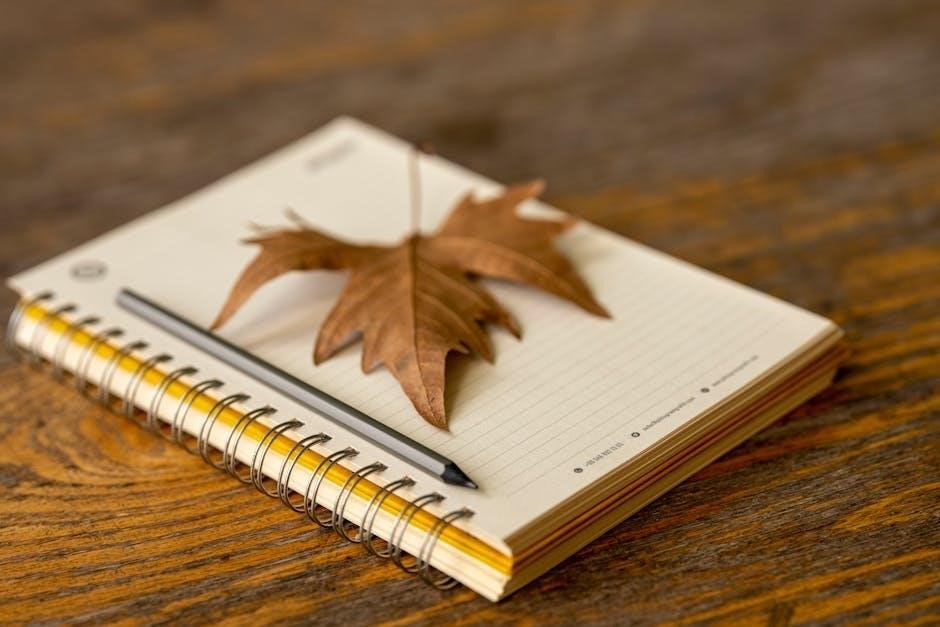
Implementation Strategies for Teachers
Teachers can introduce reflection sheets during class meetings or after incidents, guiding students through the process․ Consistently integrate them into daily routines to foster accountability and positive change․
4․1 How to Introduce the Concept to Students
Introduce behavior reflection sheets by explaining their purpose in a group setting․ Discuss how they help students reflect on actions, understand consequences, and make better choices․ Emphasize that the tool is for growth, not punishment․ Use a simple example or scenario to demonstrate its use, ensuring students understand the process․ Encourage open questions and create a safe environment for honest reflection․ Consistency and positive reinforcement will help students embrace this practice as a valuable learning tool․
4․2 Integrating Reflection Sheets into Classroom Routine
To integrate reflection sheets, introduce them after incidents or as a regular practice․ Start with short, focused sessions, ensuring students understand the purpose․ Incorporate them into daily routines, such as after morning check-ins or at the end of the day․ Consistency is key to making reflection a habit․ Provide clear expectations and model the process to encourage participation․ Over time, students will see the value in reflecting on their actions, fostering a culture of accountability and self-improvement in the classroom․

Real-Life Applications of Behavior Reflection Sheets
Schools use behavior reflection sheets to address conflicts and improve student actions․ They guide students to understand their behaviors and the impact on others, fostering positive change․
5․1 Case Studies of Successful Implementation
Several middle schools have reported success using behavior reflection sheets to address peer conflicts and improve student actions․ For instance, Robbinsdale Cooper High School implemented a restorative reflection sheet, prompting students to reflect on incidents and their impact․ Teachers noted a reduction in repeat offenses and improved accountability․ One middle school teacher shared that using these sheets weekly helped students take responsibility for their actions, fostering a more respectful classroom environment․ These case studies highlight the tool’s effectiveness in promoting positive behavioral change and conflict resolution․
5․2 Testimonials from Teachers and Students
Teachers and students have praised behavior reflection sheets for their positive impact․ One teacher shared, “These sheets have helped students take accountability for their actions, leading to better behavior and self-awareness․” A student remarked, “Reflecting on my actions helps me understand why I made certain choices and how I can improve․” Parents also appreciate the tool, noting it fosters consistency between home and school․ Many have seen significant improvements in their children’s ability to think critically about their behavior and make better decisions․
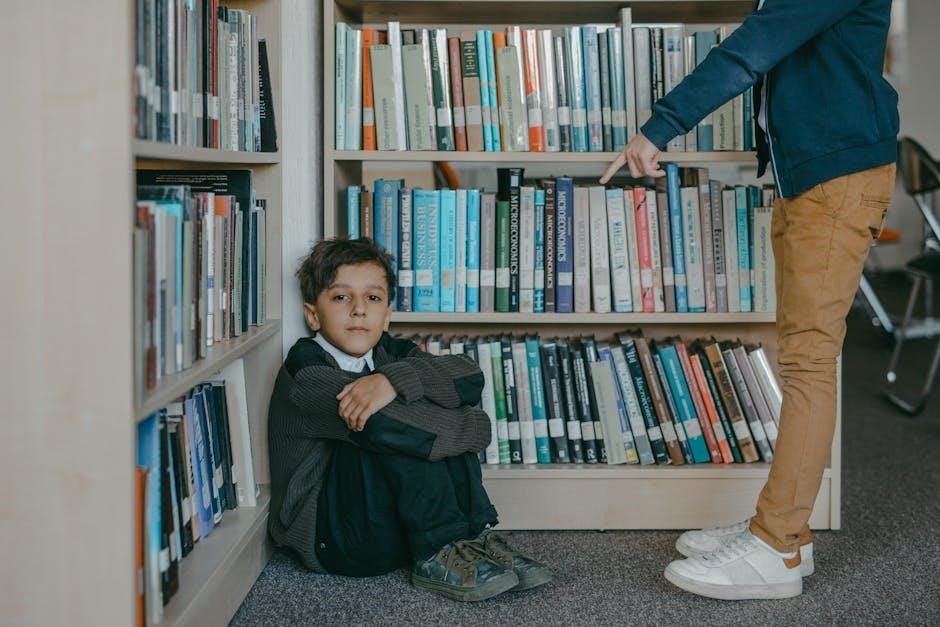
Psychological and Educational Benefits
Behavior reflection sheets enhance self-awareness, emotional intelligence, and critical thinking․ They promote accountability, fostering a deeper understanding of actions and their consequences, benefiting both personal and academic growth․
6․1 Understanding the Psychology Behind Reflection
Reflection is rooted in psychology, fostering self-awareness and emotional intelligence․ It encourages students to analyze their actions, emotions, and consequences, promoting personal growth and responsibility․ By engaging in reflective practices, students develop critical thinking skills, empowering them to make better decisions․ Reflection also enhances empathy, as students consider how their behavior impacts others․ This process aligns with social-emotional learning, helping students navigate complex social dynamics and build stronger relationships․ Regular reflection can reduce impulsive behaviors and create a more thoughtful, accountable mindset․
6․2 Link to Social-Emotional Learning (SEL)
Behavior Reflection Sheets align closely with Social-Emotional Learning (SEL) by fostering self-awareness, self-management, and relationship skills․ Reflection helps students identify emotions, understand consequences, and develop empathy․ By encouraging goal-setting and self-accountability, these tools support SEL competencies like decision-making and problem-solving․ Integrating reflection sheets into SEL frameworks enables students to connect their actions to personal growth, fostering a more thoughtful and resilient mindset․ This approach helps students navigate social challenges and build stronger, more positive relationships with peers and adults․
Setting Goals for Behavioral Improvement
Behavior Reflection Sheets help students identify areas for improvement and set SMART goals․ By tracking progress, students can develop self-awareness and work toward positive behavioral changes effectively․
7․1 Creating SMART Goals
Creating SMART goals is essential for effective behavioral improvement․ SMART stands for Specific, Measurable, Achievable, Relevant, and Time-bound․ Students should define clear, specific actions they want to change, such as reducing disruptive behavior․ Goals must be measurable, like tracking progress through reflection sheets․ They should also be achievable and relevant to the student’s growth․ Setting a timeline ensures accountability․ Teachers can guide students in crafting these goals, ensuring they align with individual needs and classroom expectations․ This structured approach helps students take ownership of their development and fosters lasting positive change․
7․2 Tracking Progress Over Time
Tracking progress over time is crucial to assess the effectiveness of behavior reflection sheets․ Teachers can review completed sheets regularly to monitor changes in behavior and attitudes․ Consistency in tracking helps identify patterns and areas needing further attention․ By documenting improvements, students can see their growth, fostering motivation․ This longitudinal approach supports long-term behavioral development, ensuring that positive changes are sustained․ Regular monitoring also allows for timely interventions, reinforcing the reflection process and its impact on student conduct․
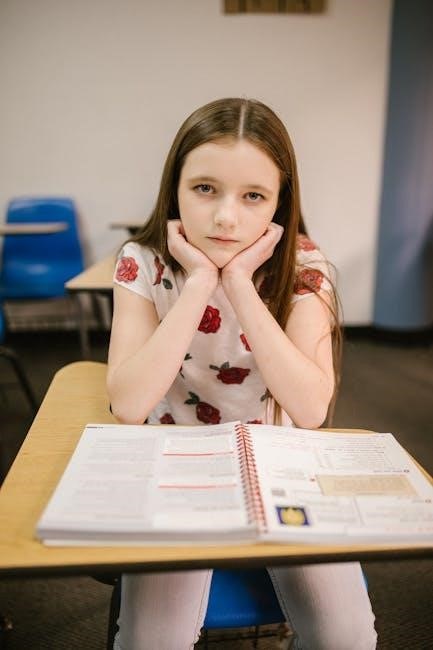
Digital vs․ Printable Behavior Reflection Sheets
Digital sheets offer accessibility and easy editing, while printable versions provide a traditional, tangible experience․ Both formats cater to different classroom needs and preferences for effective reflection․
8․1 Pros and Cons of Digital Versions
Digital behavior reflection sheets offer enhanced accessibility and convenience, allowing students to complete them anywhere with internet access․ They can be easily edited, saved, and shared, reducing paper waste․ Digital versions also enable real-time feedback and tracking of progress over time, which can be motivating for students․ However, they may require technical skills and consistent internet access, which can be a barrier for some․ Additionally, digital formats might lead to distractions if students are prone to multitasking during reflection time․
8․2 Tools for Creating Digital Reflection Sheets
Teachers can use tools like Google Forms, Microsoft Excel, or Canva to create digital behavior reflection sheets․ These platforms are user-friendly and allow for customization․ Google Forms is ideal for creating interactive surveys or questionnaires, while Excel or Google Sheets can be used for structured tables and checklists․ Canva offers templates for visually appealing designs․ These tools save time, enable easy sharing, and allow for real-time collaboration, making them ideal for creating and distributing digital reflection sheets to middle school students․
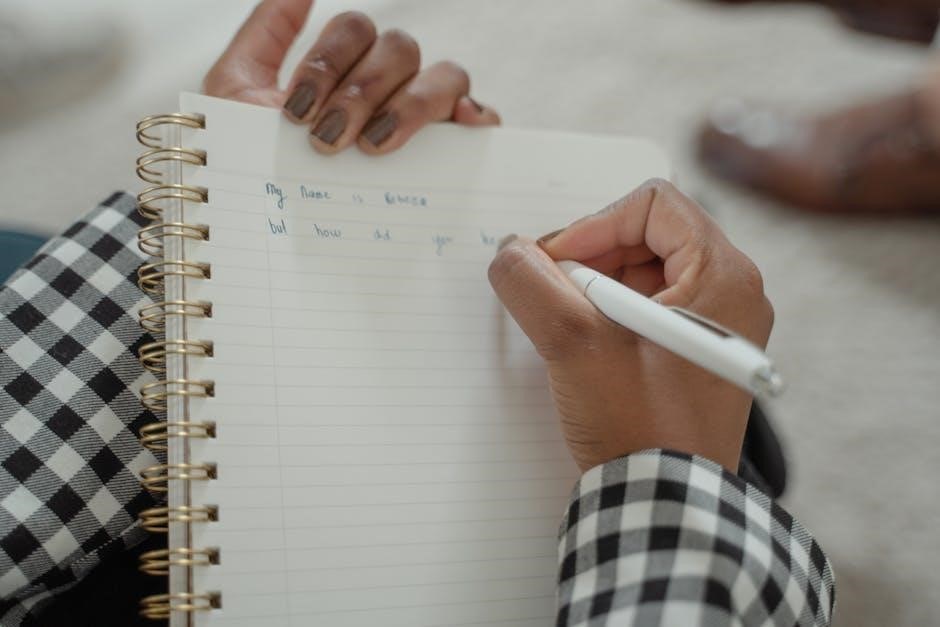
Role of Parents in the Reflection Process
Parents play a crucial role in the reflection process by encouraging open discussions with their children, reinforcing positive behaviors, and maintaining consistency with school expectations․
9․1 How Parents Can Support Behavioral Reflection
Parents can support behavioral reflection by reviewing the reflection sheets with their child, discussing the incidents, and helping them set realistic goals for improvement․ Encouraging open conversations about feelings and consequences reinforces the learning process․ Parents can also reinforce positive behaviors at home, creating a consistent environment that aligns with school expectations․ By fostering accountability and providing guidance, parents play a vital role in helping students develop self-awareness and make better choices in the future․
9․2 Communicating with Teachers for Consistency
Consistency between home and school is crucial for effective behavioral reflection․ Parents should maintain regular communication with teachers to stay informed about their child’s progress and challenges․ This collaboration ensures that strategies for improvement are aligned and reinforced in both settings․ By working together, parents and teachers can create a unified approach, helping students understand expectations and fostering accountability․ Sharing insights from reflection sheets can also provide a comprehensive view of the student’s growth, enabling targeted support and encouraging positive behavioral development․

Addressing Challenges and Resistance
Challenges may include student resistance or inconsistent use․ Teachers can overcome these by providing clear incentives and training, ensuring the process remains fair and non-punitive․
10․1 Common Obstacles in Implementation
Common obstacles include student resistance, with some hesitating to reflect openly․ Time constraints and inconsistent use by teachers can also hinder effectiveness; Additionally, ensuring honest responses and maintaining fairness in the process can present challenges․ Teachers may need to address these issues by providing clear guidelines and fostering a supportive environment․ Open communication and consistent follow-up are key to overcoming these barriers and ensuring the reflection process remains effective and meaningful for all students․
10․2 Strategies to Overcome Student Resistance
To overcome resistance, teachers can introduce reflection sheets gradually, explaining their purpose and benefits․ Making the process interactive, such as using digital tools or group discussions, can increase engagement․ Providing examples of completed sheets and ensuring anonymity can encourage honesty․ Positive reinforcement, like acknowledging progress, can also motivate students․ Involving students in setting goals and fostering a supportive environment helps reduce reluctance and promotes meaningful participation in the reflection process․
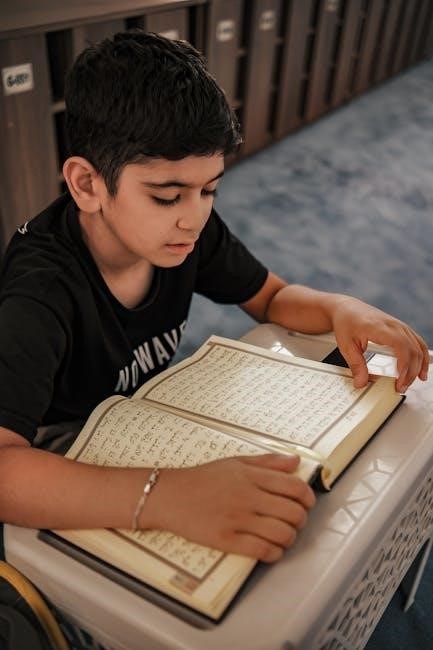
Measuring Effectiveness
Effectiveness is measured by tracking behavior changes, feedback from teachers, and goal attainment, ensuring reflection sheets foster positive student development over time․
11․1 Assessing the Impact on Student Behavior
Evaluating the impact involves observing behavior changes, tracking incident reductions, and reviewing student self-assessments․ Teachers monitor progress, noting improved accountability and responsibility․ Feedback from students and educators highlights shifts in classroom dynamics, with many reporting fewer disruptions and enhanced focus․ The reflection process fosters a culture of self-awareness, leading to more thoughtful decision-making․ Over time, the consistent use of reflection sheets helps students develop better emotional regulation and interpersonal skills, creating a more positive learning environment․
11․2 Using Feedback to Improve the Reflection Process
Feedback from students, teachers, and parents is crucial for refining reflection sheets․ Teachers can adjust questions or formats based on student responses and effectiveness․ Students’ input helps ensure the tool is relevant and engaging․ Regularly reviewing feedback allows educators to identify patterns and areas for improvement, enhancing the reflection process․ This iterative approach ensures the sheets remain effective in fostering accountability and positive behavior, making them a dynamic tool for student growth and classroom management․
Behavior Reflection Sheets are a powerful tool for fostering accountability and encouraging positive change in middle school students, aiding in their personal growth and improved decision-making skills․
12․1 Summary of Key Points
Behavior Reflection Sheets are effective tools that help middle school students understand their actions and consequences․ They promote self-reflection, accountability, and personal growth․ By encouraging students to evaluate their behavior, these sheets foster a deeper understanding of appropriate conduct․ They are customizable to meet individual needs and can be used in various classroom scenarios․ The sheets also support positive behavioral change by helping students identify areas for improvement․ Overall, they serve as a valuable resource for educators aiming to create a respectful and focused learning environment, empowering students to make better choices․
12․2 Final Thoughts on the Value of Reflection Sheets
Behavior Reflection Sheets are invaluable tools for fostering self-awareness and accountability in middle school students․ By encouraging students to reflect on their actions, these sheets empower them to take responsibility for their behavior and make positive changes․ They create a structured yet supportive environment for personal growth, helping students develop essential life skills like self-regulation and empathy․ Ultimately, reflection sheets are a powerful resource for educators, promoting a culture of accountability and respect, and equipping students with the tools needed for long-term success․

Additional Resources
Discover free PDF templates, educational articles, and recommended reading to deepen your understanding of Behavior Reflection Sheets for middle school settings․
13․1 Where to Find Free PDF Templates
Free PDF templates for behavior reflection sheets can be found on educational websites, teacher resource platforms, and school websites․ Many educators share customizable templates that cater specifically to middle school needs․ Websites like Teachers Pay Teachers and Google Workspace offer downloadable and editable versions․ These templates often include prompts to guide students in reflecting on their actions, understanding consequences, and setting goals for improvement․ They are designed to be user-friendly and adaptable to different classroom environments, ensuring they meet the unique requirements of each student and teacher;
13․2 Recommended Reading and Further Learning
For deeper insights, explore books on restorative practices and social-emotional learning․ Online courses on classroom management and behavioral strategies are also valuable․ Educational journals often feature articles on reflection-based interventions․ Websites like Edutopia and ASCD provide extensive resources․ Additionally, professional development workshops can offer practical strategies for implementing reflection sheets effectively․ These resources help educators refine their approach, ensuring students benefit fully from reflective practices․


